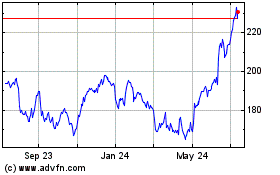Apple Petitions to Sell Refurbished iPhones in India
May 05 2016 - 2:20PM
Dow Jones News
NEW DELHI—India's government is weighing a proposal by Apple
Inc. to refurbish and sell secondhand iPhones in the country,
officials said, as the tech giant tries to gain traction in a
fast-growing and populous, but not very affluent, market.
Success in new markets like India will be central to the
Cupertino, Calif., company's expansion, analysts said. Apple last
week reported its first quarterly revenue decline since 2003 amid
falling sales of its smartphones in China.
In India, however, Apple Chief Executive Tim Cook told analysts
that iPhone sales had jumped 56% in the three months ended March 26
from the same period a year earlier. Apple's market share for
smartphones in the country remains small at roughly 2%.
Used phones would let Apple offer a less-expensive product in a
country where 70% of smartphones sold last year cost less than
$150. IPhones, by comparison, typically cost $500 to $1,000 without
a data plan in India.
"The target consumer in India is still looking for more value
for money" and have many other cheaper models to choose from, said
Rushabh Doshi, an analyst at research firm Canalys in
Singapore.
Apple sells refurbished devices, which have been repaired or had
parts replaced, in many countries, including the U.S. In some
countries, it also offers what it calls certified preowned
products, which contain a mix of new and reused components.
In India, the company has applied to make and sell certified
preowned iPhones, according to government officials. "We are
looking into the issues related to Apple's proposal," a senior
official in the Prime Minister's Office said Wednesday. The
official, who declined to be named, said the country was concerned
about ending up with potentially hazardous electronic waste.
Apple declined to comment on concerns that its products might
generate hazardous electronic waste. In its most recent environment
report, Apple said it "disposes of hazardous waste
responsibly."
Prakash Javadekar, India's minister for environment, forest and
climate change, said his agency was evaluating Apple's plan, as did
an official who declined to be named at India's Telecom Ministry,
which oversees policies related to the electronics industry.
Pardeep Jain, managing director of smartphone maker Karbonn
Mobile India Pvt., an Apple rival, said he wasn't opposed to
Apple's proposal, since he believes most consumers in India prefer
new phones and don't want to buy used phones.
Newton, Mass.-based research firm Strategy Analytics projects
some 149 million smartphones will be sold in India this year, up
26% from last year. India is expected to overtake the U.S. in
smartphone sales next year, which would make it second only to
China. Price is a big challenge for Apple in India, where average
per capita income is about $1,500 a year. Apple's new iPhone SE,
its cheapest-ever handset, typically costs more than $500 in
India.
The best-selling iPhone model in India is now the older iPhone
5S model, which costs about $300 and accounted for some 50% of
sales in the first quarter of this year, said Tarun Pathak, a
Delhi-based analyst with Counterpoint.
The iPhone SE is intended to replace the 5S. Mr. Pathak said
that will leave Indian consumers with only pricier models. Used or
refurbished devices, if allowed in India, could help Apple fill the
gap at the low end, he said.
Apple in recent months has lowered prices in India, ramped up
advertising and expanded its distribution network to get devices
into smaller towns and cities.
In January, the company said it had sought the government's
approval to open its own retail stores and sell products online,
rather than simply through Indian-owned retailers and distribution
firms. The proposal is pending, and a government panel recommended
last week that Apple be granted a waiver from using locally made
parts.
Sean McLain contributed to this article.
(END) Dow Jones Newswires
May 05, 2016 14:05 ET (18:05 GMT)
Copyright (c) 2016 Dow Jones & Company, Inc.
Apple (NASDAQ:AAPL)
Historical Stock Chart
From Mar 2024 to Apr 2024

Apple (NASDAQ:AAPL)
Historical Stock Chart
From Apr 2023 to Apr 2024
